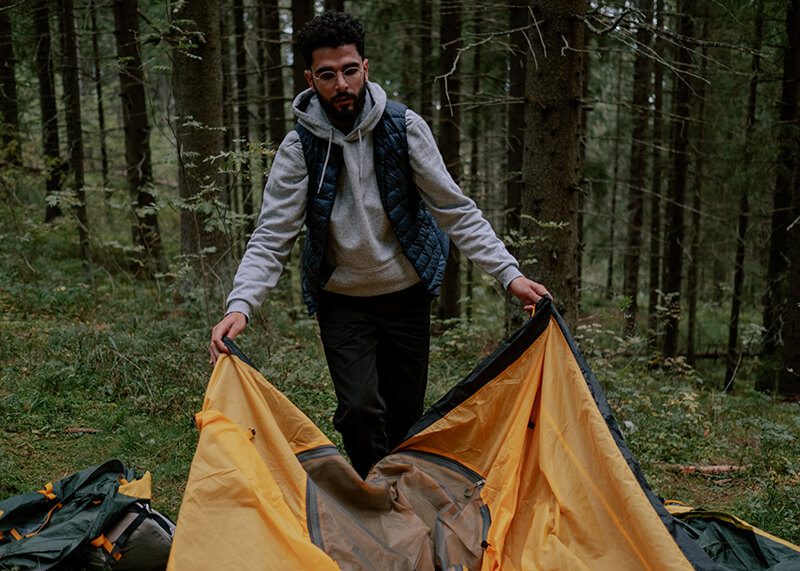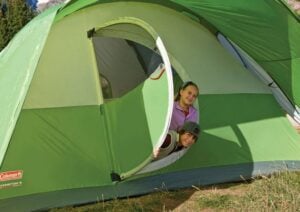Whether you love to camp, or you’re just getting started, then you know that one of the most important things to bring with you on your trip is your tent.
But do you know how to set up a tent properly? In this blog post, we’ll walk you through the process step-by-step so that you can set up your tent like a pro.
We’ll cover everything from choosing the right site to pitching the tent correctly. Whether you’re a beginner or an experienced camper, you’ll find everything you need here.
So what are you waiting for? Let’s get started!
What are the steps for a successful tent setup?
There are a few simple steps that you’ll want to follow in order to set up your tent correctly. Here’s a quick overview:
- Choose the right site
- Check the weather conditions
- Layout the base
- Spread the tent canopy
- Assemble the tent poles
- Peg down the corners of the tent
- Pitch the tent
- Add the rainfly and stake it down
- Secure the tent with guylines
- Test the tent
What tools are required for a proper tent setup?
Make sure you have the right supplies. You’ll need a tent, stakes, a mallet or hammer, and a rope. Depending on the type of tent you have, you may also need poles and clips.
With a dome tent, for example, you’ll need to insert the poles into the appropriate sleeves and then clip them together.
What’s the difference between pitching a tent and setting up a tent?
Pitching a tent is the process of putting up the frame of the tent. Once the frame is set up, you’ll then need to spread out the flat tent and secure it in place.
Setting up a tent is the process of attaching the tent to its frame. This is usually done by threading tent poles through sleeves on the fabric and then securing them in place.
🏕 10 Steps on how to set up tent for camping
Camping trips are a great way to get up close and personal with nature, but before you choose your campsite, there are a few things you need to take into consideration.
In this section, we’ll walk you through the ten steps you need to take in order to set up your tent for a successful camping trip. Here are 10 steps to follow:

1. How to choose the right site for your tent
If you don’t take the time to select an appropriate spot, you could run into a number of problems, such as not being able to set up your tent, or worse, getting injured.
That’s why it’s so important to be aware of the factors that go into choosing a good campsite.
Some of the most important things to take into account include:
- The condition of the ground: Is the ground level and relatively free of rocks and sticks? If not, you’ll need to find a site with better soil.
- The space available: Make sure you have enough space to pitch your tent, as well as room to store your tent gear.
- The surrounding area: Is the campsite in a secluded area or is it close to other campers? You’ll also want to take into account things like wind direction and potential wildlife.
2. Check the weather conditions
It’s important to always check the weather forecast before you go camping and to be especially mindful of weather conditions when pitching your tent.
Some things you’ll want to consider include:
- The wind speed: If the wind is too strong, it could damage your tent or blow it away.
- The rain: A sudden downpour can quickly turn a campsite into a muddy mess, and if your tent isn’t waterproof, you’ll get wet. Check out our 7 simple steps on how to waterproof you tent.
- The temperature: A cold night can be uncomfortable, and in extreme cases, dangerous.
3. Layout the tent base
Once you’ve selected a site, it’s time to set up your tent’s footprint if you have one. Not sure if a tent footprint is worth it? Learn more about tent footprints and if they’re worth it.
The tent base is a piece of durable material that goes underneath the tent and helps protect the ground from wear and tear caused by the bottom of your tent. They come in a variety of shapes and sizes to fit different types of tents. It also makes it easier to pitch the tent on uneven terrain.
Nowadays most tents typically come with their own footprints, but if you’re using an older model or if yours didn’t come with one, you can buy one online or at your local sporting goods store.

4. Spread the tent canopy
Once you have the footprint laid out, it’s time to lay out the tent fabric. Most tents have two pieces of fabric: the canopy and the fly. The canopy is the main part of the tent that you’ll sleep in, while the fly goes over the top and protects the tent from rain and wind.
Rest the canopy on top of the footprint, and place the fly somewhere safe for later, or place it back in your tent carry bag if you don’t expect it to rain.

5. Assemble the tent poles
The tent poles are the frame of your tent, and they come in a variety of shapes and sizes depending on the type of tent you have.
Before you can pitch your tent, you’ll need to assemble the tent poles to the best of your ability. This is usually done by connecting them together and then inserting them into sleeves on the fabric.
Be sure to read the tent instructions that come with your tent, as there can be slight variations in how to put the tent poles together.
6. Peg down the corners of the footprint
Once you have the tent poles assembled, it’s time to grab the tent pegs and stake down the tent corners of the footprint. This will help keep the fabric in place and prevent it from blowing away in windy conditions.
Most footprints come with their own stakes, but if you’re using an older model or if yours didn’t come with any, you can buy them online or at your local sporting goods store.

7. Pitch the tent
Now it’s time to pitch the tent. This is done by inserting the poles into the sleeves on the fabric and then using the stakes to secure them in place.
Be sure to pitch your tent in an area that’s free of rocks and sticks, as they could damage the fabric or pole.
If you’re not familiar with pitching a tent, there are a number of online tutorials that can help.

8. Add the rain fly and stake it down
Once the tent is pitched, it’s time to add the rain fly. This is a piece of fabric that goes over the top of the tent and helps keep you and your gear dry in case of rain.
Stake down the corners of the rain fly to keep it from blowing away in windy conditions.
Most rain flies have metal grommets in the corners that can be attached to poles on the canopy with hooks or ties. If your rain fly doesn’t have any grommets, you can use small rocks or sticks to hold it in place.

9. Secure the tent with guy lines
Many modern tents come with guy lines, which are ropes that help keep the tent stable in windy conditions. If your tent doesn’t come with any, you can buy them online or at your local sporting goods store.
Guy lines should be attached to the stakes at the corners of the footprint and then stretched out taut. This will help keep the tent from blowing away in windy conditions.
10. Enjoy your camping experience!
Now that your tent is set up, it’s time to enjoy your camping trip! Be sure to practice packing it up before you leave so you can do it quickly and efficiently.
If you have any questions about setting up or packing up your tent, be sure to ask a friend or consult the tent instruction manual that came with your tent.
9 Tips for Setting up a Tent in Different Scenarios
The tent setup process may vary slightly depending on the type of tent you have, so it’s important to consult the instructions that came with your tent.
However, here are a few general tips for setting up a tent in different scenarios:
1. How to set up a tent for the first time
When setting up a new tent, it’s important to read the instructions carefully. There can be slight variations in how to put the tent poles together, so it’s important to follow the instructions closely. It’s also a good idea to practice pitching the tent in your backyard before taking it on camping trips.
2. How to set up a tent in under 5 minutes
If you’re in a hurry, here are a few tips for setting up your tent quickly:
- Make sure you have all of the necessary pieces and parts before you start. This will help avoid confusion and speed up the process.
- Follow the instructions carefully and practice setting up the tent beforehand. This will help ensure that you can do it quickly in a hurry.
- Set up the tent poles first, then peg down the corners of the footprint. This will help keep the fabric in place while you’re assembling the poles.
- Add the rain fly last, after the tent is pitched. This will help keep you and your gear dry in case of rain.
3. How to set up a tent in the rain
When setting up a tent in the rain, it’s important to take your time and be careful. Here are a few tips for setting up your tent in wet conditions:
- Make sure the ground is dry before pitching the tent. This will help avoid water seeping into the fabric.
- If the ground is wet, try to find a dry spot to pitch your tent. Pitching your tent on a wet surface will only make things worse.
- Lay down a protective tarp or footprint before pitching the tent. This will help keep the inside of the tent dry and will also protect the bottom of the tent from getting wet.
- Pitch the tent under an overhang or in an area that’s protected from the rain.
- Add the rain fly to your tent if it doesn’t have one. This will help keep you and your gear dry in case of rain.
4. How to set up a tent with two people
If you’re setting up a tent with two people, it’s important to communicate and work together. Here are a few tips for setting up your tent quickly and efficiently:
- Make sure all of the pieces are accounted for before starting to set up the tent. This will help avoid confusion and speed up the process.
- One person should hold the tent’s poles while the other person attaches the fabric.
- Both people should be involved in pitching the tent. This will help ensure that it’s done correctly and quickly.
5. How to set up a tent on the sand
If you’re camping on the beach or on the sand, it’s important to know how to set up your tent on the sand.
Here are a few tips for setting up your tent in this environment:
- Use a large tarp or an extra sheet to create a floor for your tent. This will help prevent the sand from getting inside your tent and also keep it out of your sleeping bag.
- If you’re using stakes to secure your tent, make sure that you drive them into the sand as deep as possible. You may also want to use additional weighting, such as rocks or logs, to keep the tent in place.
- Pitching your tent on the windward side of a dune can help protect it from the sand and wind.
- Make sure that you stake down your guy lines well, especially if there is a lot of wind. This will help keep your tent from blowing away.
- If you’re using a windbreak, set it up on the leeward side of your tent. This will help to protect your shelter from the wind and sand.
6. How to set up a tent with kids
If you’re on a family camping trip with kids, it’s important to set up your tent before it gets dark. This will help avoid any accidents that might occur in the dark. Here are a few tips for setting up your tent with kids:
- Show your kids how to set up the tent before you leave home. This will help them feel more confident and know what to do when they’re on their own.
- Make sure the area around the tent is clear of any potential hazards, like rocks or sticks.
- Help your kids with the tent stake process so it doesn’t blow away in the wind.
- Make sure they know not to go near the campfire unsupervised.
- Have fun! camping is a great way to spend time with your family and explore nature.
7. How to set up a tent for backpackers
If you’re backpacking, it’s important to pack light. That means leaving your tent at home and using a tarp instead. Here are a few tips for setting up your tarp for backpacking:
- If you’re using poles, make sure they are the correct length and that you have enough of them.
- Layout the tarp and orient it in the direction you want it to go.
- If you’re using a trekking pole or two sticks for support, place them in the grommets in the corners of the tarp.
- Pull the tarp tight and stake it down.
- If you’re using ropes, tie them to the grommets in the corners of the tarp.
- Place your gear in the middle of the tarp and use it as a shelter.
8. How to set up a tent on a slope
When you’re setting up your tent on a slope, it’s important to put the heavier end of the tent uphill. This will help keep your tent from sliding down the slope. You may also want to use stakes and guy lines to secure your tent in place.
9. How to set up a tent when you’re camping alone
When camping alone, it’s important to set up your tent in a safe and secure location. It can also be helpful to put your tent poles in the sleeves before you stake them down. This will help keep the poles in place and make them easier to set up.
Frequently Asked Questions
How can I keep my tent from blowing away in the wind?
Make sure to stake your tent down properly, use a windbreak, or put it in a sheltered spot.
What should I do if it rains while I’m camping?
If your tent has a rainfly, put it on top of the tent and fasten the Velcro straps. If your tent doesn’t have a rainfly, you can put a tarp over the top of the tent. Make sure the tarp is well secured so it doesn’t blow away in the wind.
How do I set up a tarp for backpacking?
If you’re using poles, make sure they are the correct length and that you have enough of them. Layout the tarp and orient it in the direction you want it to go. If you’re using a trekking pole or two sticks for support, place them in the grommets in the corners of the tarp. Pull the tarp tight and stake it down. If you’re using ropes, tie them to the grommets in the corners of the tarp. Place your gear in the middle of the tarp and use it as a shelter.
Can I set up my tent on concrete?
You can set up your tent on concrete, but make sure to use stakes or anchors to keep it from blowing away. You may also want to put your tent away from the water to avoid getting wet.
What should I do if my tent starts to leak?
If your tent is leaking, you can try to fix it yourself or take it back to the store where you bought it. Some common problems that can cause a tent to leak are missing or damaged rainfly, poles that are not the correct length, and stakes that are not properly secured.
Recap and Further Reading
Setting up a tent correctly is key to a comfortable and safe camping experience. Whether you’re using a tent for backpacking, camping with kids, or in the snow, following these tips will help ensure you have a successful trip. Check out some of our other articles for more information on the different types of tents, and how to buy a tent.





